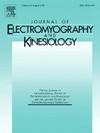Comparison of muscle activity between isokinetic and iso-inertial exercise
IF 2.3
4区 医学
Q3 NEUROSCIENCES
引用次数: 0
Abstract
Background
Resistance training plays a crucial role in musculoskeletal rehabilitation and athletic performance. Traditional resistance training often underloads the eccentric phase, as muscles generate more force while lengthening. Isokinetic and iso-inertial exercises have been used to overcome this limitation, with both showing greater muscle activity compared to traditional methods, potentially leading to enhanced strength and hypertrophy. However, limited research compares the two modalities.
Methods
This randomised crossover study involved healthy adults between the ages of 18–45 years who performed isokinetic knee extensions and iso-inertial squats at fast and slow speeds. Electromyographic activity of the quadriceps was recorded, and the eccentric-to-concentric root-mean-square (RMS) ratio was calculated.
Results
Results showed that iso-inertial exercise at fast speeds led to a significantly greater eccentric-to-concentric RMS ratio in the rectus femoris (95 % CI 0.11 to 0.74; Cohen’s d = 0.89) and vastus lateralis (95 % CI 0.07 to 0.55, Cohen’s d = 0.75) compared to isokinetic exercise, with no difference in vastus medialis or at slow speeds.
Conclusion
Conclusion: These findings indicate that iso-inertial exercise induces greater eccentric muscle activity in key quadriceps muscles at fast speeds, suggesting its potential for enhancing eccentric overload and muscle strength gains.
等速运动和等惯性运动肌肉活动的比较
背景:阻力训练在肌肉骨骼康复和运动表现中起着至关重要的作用。传统的阻力训练通常会使离心阶段负荷不足,因为肌肉在拉伸时产生更多的力量。等速运动和等惯性运动已被用于克服这一限制,与传统方法相比,两者都显示出更大的肌肉活动,潜在地导致力量增强和肥大。然而,比较这两种模式的研究有限。方法:这项随机交叉研究纳入了年龄在18-45岁之间的健康成年人,他们在快、慢速度下进行等速膝关节伸展和等速惯性深蹲。记录股四头肌肌电活动,计算偏心与同心均方根(RMS)比。结果结果显示,与等速运动相比,快速等惯性运动导致股直肌(95% CI 0.11 ~ 0.74, Cohen’s d = 0.89)和股外侧肌(95% CI 0.07 ~ 0.55, Cohen’s d = 0.75)的离心-同轴RMS比显著增大,而股内侧肌和慢速运动无差异。结论:这些结果表明,等惯性运动在快速运动时可诱导关键股四头肌的偏心肌活动,提示其可能增强偏心过载和肌肉力量的增加。
本文章由计算机程序翻译,如有差异,请以英文原文为准。
求助全文
约1分钟内获得全文
求助全文
来源期刊
CiteScore
4.70
自引率
8.00%
发文量
70
审稿时长
74 days
期刊介绍:
Journal of Electromyography & Kinesiology is the primary source for outstanding original articles on the study of human movement from muscle contraction via its motor units and sensory system to integrated motion through mechanical and electrical detection techniques.
As the official publication of the International Society of Electrophysiology and Kinesiology, the journal is dedicated to publishing the best work in all areas of electromyography and kinesiology, including: control of movement, muscle fatigue, muscle and nerve properties, joint biomechanics and electrical stimulation. Applications in rehabilitation, sports & exercise, motion analysis, ergonomics, alternative & complimentary medicine, measures of human performance and technical articles on electromyographic signal processing are welcome.

 求助内容:
求助内容: 应助结果提醒方式:
应助结果提醒方式:


